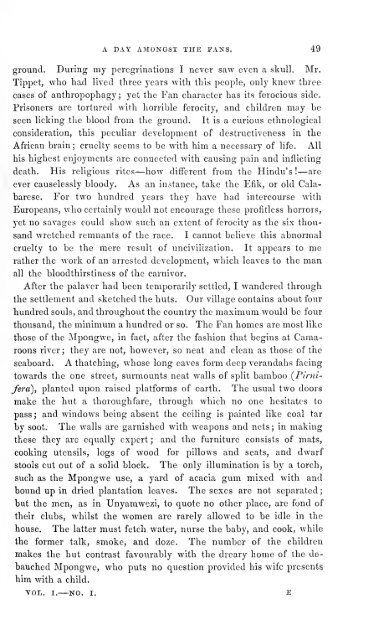The anthropological review - National Library of Scotland
The anthropological review - National Library of Scotland
The anthropological review - National Library of Scotland
You also want an ePaper? Increase the reach of your titles
YUMPU automatically turns print PDFs into web optimized ePapers that Google loves.
A DAY AMONGST THE FANS. 49<br />
ground. During my peregrinations I never saw even a skull. Mr.<br />
Tippet, who had lived three years with this people, only knew three<br />
cases <strong>of</strong> anthropophagy ; yet the Fan character has its ferocious side.<br />
Prisoners are tortured with horrible ferocity, and children may be<br />
seen licking the blood from the ground. It is a curious ethnological<br />
consideration, this peculiar development <strong>of</strong> destructiveness in the<br />
African brain ; cruelty seems to be with him a necessary <strong>of</strong> life. All<br />
his highest enjoyments are connected with causing pain and inflicting<br />
death. His religious rites—how different from the Hindu's!—are<br />
ever causelessly bloody. As an instance, take the Efik, or old Cala-<br />
barese. For two hundred years they have had intercourse with<br />
Europeans, who certainly would not encourage these pr<strong>of</strong>itless horrors,<br />
yet no savages could show such an extent <strong>of</strong> ferocity as the six thou-<br />
sand wretched remnants <strong>of</strong> the race. I cannot believe this abnormal<br />
cruelty to be the mere result <strong>of</strong> uncivilization. It appears to me<br />
rather the work <strong>of</strong> an arrested development, which leaves to the man<br />
all the bloodthirstiness <strong>of</strong> the carnivor.<br />
After the palaver had been temporarily settled, I wandered through<br />
the settlement and sketched the huts. Our village contains about four<br />
hundred souls, and throughout the country the maximum would be four<br />
thousand, the minimum a hundred or so. <strong>The</strong> Fan homes are most like<br />
those <strong>of</strong> the Mpongwe, in fact, after the fashion that begins at Cama-<br />
roons river ; they are not, however, so neat and clean as those <strong>of</strong> the<br />
seaboard. A thatching, whose long eaves form deep verandahs facing<br />
towards the one street, surmounts neat walls <strong>of</strong> split bamboo (P/rn*-<br />
fera), planted upon raised platforms <strong>of</strong> earth. <strong>The</strong> usual two doors<br />
make the hut a thoroughfare, through which no one hesitates to<br />
pass; and windows being absent the ceiling is painted like coal tar<br />
by soot. <strong>The</strong> walls ai'e garnished with weapons and nets ; in making<br />
these they are equally expert; and the furniture consists <strong>of</strong> mats,<br />
cooking utensils, logs <strong>of</strong> wood for pillows and seats, and dwarf<br />
stools cut out <strong>of</strong> a solid block. <strong>The</strong> only illumination is by a torch,<br />
such as the Mpongsve use, a yard <strong>of</strong> acacia gum mixed with and<br />
bound up in dried plantation leaves. <strong>The</strong> sexes are not separated<br />
but the men, as in Unyamwezi, to quote no other place, are fond <strong>of</strong><br />
their clubs, whilst the women are rarely allowed to be idle in the<br />
house. <strong>The</strong> latter must fetch water, nurse the baby, and cook, while<br />
the former talk, smoke, and doze. <strong>The</strong> number <strong>of</strong> the children<br />
makes the hut contrast favourably with the dreary home <strong>of</strong> the de-<br />
bauched Mpongwe, who puts no question provided his wife presents<br />
him with a child.<br />
VOL. I.—NO. I. E<br />
;

















